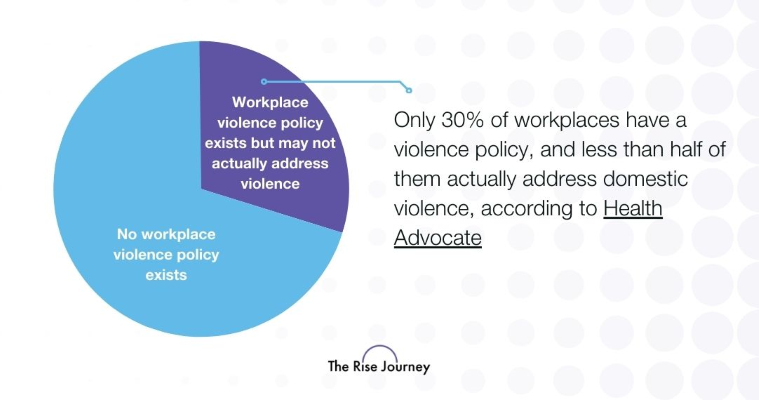Why Domestic Violence Must be Included in Your DEI Strategy
Person emotionally hurting and crying at the side of their bed.
Content Warning:
This blog may include content that is difficult or upsetting for individuals to read. The Rise Journey respects everyone’s right to be aware and in control of the content they consume.
Continue below if you would like to read the blog or download 4 Tips to Build a DEI Strategy that Protects Survivors.
.
.
.
Workplaces and employers have unique positions that allow them to connect with employees from all different communities, identities, and backgrounds. Yet, in today’s workplaces, connecting with employees is just the first of many steps toward a new working world. Workplace leaders hold the responsibility of not only providing employees with tools, resources, and education at all levels but also being prepared to recognize signs of abuse and take responsible action in supporting survivors experiencing or who have experienced violence.
Domestic Violence (DV) is defined by the United Nations as, “a pattern of behavior in any relationship that is used to gain or maintain power and control over an intimate partner. Abuse is physical, sexual, emotional, economic or psychological actions or threats of actions that influence another person.”
It is essential to understand the differences between domestic violence and intimate partner violence, and how they impact individuals separately:
Intimate partner violence (IPV) refers to when a survivor has a relationship but may or may not live with their partner who poses a threat.
Domestic violence (DV) refers to when a survivor or person at risk is cohabitating with their partner and face unique challenges that exist when sharing a home and living space.
In an interview below, subject matter expert and Rise Advisor Fatima M. Smith (she/her) shares detailed insight into what this looks like.
Domestic Violence (DV) and Intimate Partner Violence (IPV) by the Numbers
1 in every 4 women and 1 in 10 men will experience domestic violence within their lifetime according to the Centers for Disease Control and Prevention (CDC) and reported by SHRM.
During the pandemic, recorded instances of domestic violence increased by 8.1% in the U.S.United States following the instruction of quarantine and lockdown orders, revealed an analysis by the National Commission on COVID-19 and Criminal Justice (NCCCJ).
Graph showing that only 30% of workplaces have a violence policy
Yet, SHRM further reported that 65% of organizations do not have any existing workplace violence policy in place. Of the 30 % of those workplaces that do have a workplace violence policy, less than half (44%) of those actually address domestic violence, reported Health Advocate.
DV and IPV affect all communities, - however, certain demographics such as Black and Brown women disproportionately experience DV and IPV, and face more barriers and challenges when seeking aid.
When we envision the future for our workplaces, there is no separating employees from their real, human experiences. As employers and workplaces are constantly evolving to support employees' needs and understand their individual experiences, it is long overdue for organizations to recognize and raise awareness about the importance of addressing domestic partner violence and intimate partner violence at work.
Survivors of abuse need to be included in organizations’ DEIBA (diversity, equity, inclusion, and belonging) strategies to bridge the gap between employee experiences and employee safety within and outside of the workplace.
Strengthening DEI Efforts to Support Survivors: 4 Questions and Answers
1) How does domestic and intimate partner violence affect survivors' employment experiences?
Fatima’s Answer: In either situation, DV or IPV can definitely result in a negative impact on employment experience. Very often, employees and employers may notice signs that a colleague is in distress but do not know that these are signs of abuse.
Examples of how these distressing relationships and experiences specifically impact survivors’ employment experiences include:
Employees may feel concern or fear that the person initiating violence may show up at their job. The employee may feel on edge and distracted for their safety, or even that of their colleagues, both within and outside of the place of work.
The person initiating violence could have some form of control or may manipulate the employee’s access to transportation to work. In the office or workplace, this may look like an employee that intentionally practices leaving early or arriving late to and from work in relation to the abuse experienced within the relationship.
Survivors of domestic violence or those experiencing abuse at home may also find themselves isolated at work. For example, this may look like an employee distancing themselves from work interactions and not wanting to participate or share in conversations with people at work after recently experiencing an explosive verbal or physical argument.
Employees that have or currently experience abuse within their relationship may feel mentally and emotionally drained. You might see that they're turning in assignments or tasks late. If someone's basic needs aren't being met, it will be extremely hard for them to be a productive employee as their focus is surviving in their relationship.
While employees and peers may have seen or witnessed patterns of mistreatment and/or threat to a colleague’s safety or well-being, they may not understand that these are signs of abuse. People, and especially employers, need to understand and be cognizant of the power dynamics within the workplace when they're interacting with someone that is experiencing violence.
2) How does organizational support play a role in fostering inclusion for survivors of abuse?
Fatima’s Answer: Supporting survivors of abuse and DEI work go hand in hand - It’s all about trying to make sure that people are feeling welcome and genuinely trust their organization in order to feel safe and comfortable showing up as their authentic selves.
Organizations need to take into consideration the different socio-economic and or other marginalized factors that impact employees to best conduct communication on these sensitive subjects with care, understanding, and inclusion of all identities and their nuances.
If an employee is experiencing abuse in their relationship or home environment and they are being penalized by their supervisor or their organization, that in turn may unintentionally become another form of abuse that negatively impacts their mental, emotional, and overall state.
This is why it is essential that employers and managers are mindful of how they navigate conversations about performance with empathy and inclusively, especially when they may not have a full understanding of employees’ personal situations. Learn to communicate with compassion for the well-being of the employees rather than being direct and insensitive.
Instead of asking employees:
“What's wrong with you? Why has your work been suffering?”
Try asking:
“Hey, is everything ok? Are you able to tell me what has been different between last month and this month?
What are some of the things that are impacting you? How can I be of support?”
The mindful framing of these questions changes the entire dynamic of the conversation.
The goal is to pivot from a potentially confrontational interaction to one that demonstrates empathy toward employee well-being and encourages employees to genuinely share their experiences and potential needs.
These conversations will not always result or conclude with the employee or person disclosing that they're experiencing abuse. However, it can create an environment where employees feel seen and heard, rather than attacked and defensive.
Additionally, Employers and workplaces need to consider the importance of building a safe workplace environment that is mindful of protecting employees at work. When an employee has a partner who is exerting power, control, and abuse, it can potentially become unsafe for other employees as well.
Employers can work to create a progressive and safe workplace environment, but the reality is that it is impossible for any employer to guarantee total safety and protection.
What workplaces can do is understand the importance of protecting employee information and be intentional in using communication tools that prioritize employee safety. Employers and managers need to reevaluate how they disclose information, such as:
Where people are located during work hours
What time they are arriving to work
An employee’s schedule or availability
How to get in contact with them, and what contact information to share (if any)
3) Why should organizations support supervisors who lack experience or confidence in navigating this sensitive topic in the workplace?
Fatima’s Answer: The first answer is that it is the right thing to do. Workplaces should make sure that it is known that they don't tolerate harassment, domestic and sexual violence, or abuse.
Workplaces are also responsible for matching their words to their actions and are responsible for not putting employees at further risk by volunteering inconsistent or ill-prepared support.
Organizations must take the lead in providing education, protocol, and research in helping their employees navigate this conversation for the following reasons:
To give supervisors the tools to respond proactively, responsibly, and with understanding. When work leaders or colleagues feel unprepared to have a conversation about IPV and DV, their method of conducting this sensitive conversation may be incomplete, ineffectual, or even do more harm than good.
For example, an untrained supervisor may conduct the conversation in an unhelpful way due to ignorance or awkwardness, operating under the following thought process: ‘My boss is telling me I need to ask an employee what has happened since the last month or so in their work? If they tell me it's because they’re experiencing abuse, I don't know what to say… So I'm not going to ask that question in a direct manner….’
If an organization is able to provide training to their supervisors or their managers, employers, and employees will have the tools to effectively and empathetically have these conversations.
To prevent vicarious trauma. Understand that DV and IPV don't just affect the individual, but they create a ripple effect in our communities. Every team member has a unique lived experience, and topics related to violence, abuse, or witnessing signs of distress may trigger reactions among other individuals in the workplace. Additionally, while many people in the workplace may want to verbalize their support for and affirm a survivor, they lack the tools, knowledge, and confidence to know how to actually or responsibly put it into action.
Avoid Lawsuits. Employers must address legislation and policies that focus on the security responsibilities of workplaces to uphold their safety obligations for employees. There is also legislation that protects survivors or employees who may be experiencing IPV and Dv from workplace discrimination.
4) What is one final thought to leave workplace leaders with?
Fatima’s Answer: We cannot drop the ball when somebody is being vulnerable and sharing that they are experiencing any type of abuse whether it's verbal, financial, spiritual, or physical. We need to make sure that we're providing a space that is responsive to somebody being vulnerable and trusting us with this information.
___
This blog highlights valuable perspectives from Fatima M. Smith, Rise's Social Injustice Advisor and Speaker. To gain more powerful insights on this topic, join our Lunch & Learn session on building an inclusive workplace for survivors of domestic violence.
Take the initiative now and connect with our team to bring these impactful educational experiences to your workplace. Subscribe to Rise’s newsletter to get more topics like this directly to your inbox.



